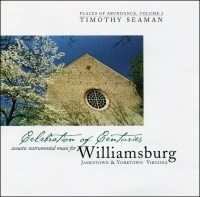|
Album Liner Notes 1. JAMES & YORK BLUFFS – Picture a seventeenth-century Powhatan Indian on the cliff above what we have come to call the James River and its College Creek tidemarsh, or the York and its tributary Queens Creek. He views a strange sailing vessel working its way up the great stream. Soon Northern Europe is introduced to North America, launching an interplay of cultures among the reeds and beeches. From ports on these creeks the City of Williamsburg as capital of Virginia would exchange goods and people with the world. (This piece is dedicated to York River State Park, a paradise of bluffs.) 2. FLOWERS OF EDINBURGH – a popular childlike Celtic reel in new duet style. ROSE TREE – “A Rose Tree in Full Bearing” is another reel that also has various texts, including this folk hymn: “There is a land of pleasure/ Where streams of joy forever roll;/ ’Tis there I have my treasure,/ And there I long to rest my soul.” FRENCH SCHOTTISCHE –a charming folk dance melody learned from Helicon. 3. WILL YE NO COME BACK AGAIN – The Scots rebels yearned for Bonny Prince Charlie’s aid, crying out in this wistful air “Ye trusted in your hieland men,/ They trusted you, dear Charlie!/ They kent [knew] your hiding in the glen,/ Death and exile braving.” (words by Caroline, Lady Nairn) Leaving the Old World forever, looking expectantly to the New: one senses the American yen for new and better life – and, one day, independence. A sojourn in Colonial National Historical Park, backward in time from Yorktown to Williamsburg to Jamestown: 4. THE WORLD TURNED UPSIDE DOWN – the tune played by British fifers at Cornwallis’ Yorktown surrender. (American fifers played “Yankee Doodle”, which you may hear in the strings – along with the National Anthem!) CHESTER – This anthem by William Billings was likely the most popular song among American soldiers during the Revolution: “When God inspired us for the fight,/Their lines were broke, their lines were forced,/ Their ships were sheltered in our sight/Or swiftly driven from our coast.” RED-HAIRED BOY – a mixolydian Scots reel popular for centuries on both sides of the Atlantic. 5. THE GREAT ROAD – Governor William Berkeley of Green Spring plantation established the first American highway in the 17th century: the “Great Road” from his mansion to Jamestown Island – and vestiges remain. Today, the National Park Service has its own “great road” from Jamestown to Yorktown, midway passing through Williamsburg itself: the Colonial Parkway. The traveler glides along gracious river beaches and tidal streams, among pines and oaks, across bluffs and marshes from the inception point of English America to the securing place of a republic’s independence. 6. PASSACAILLE – The great Baroque composer G. F. Handel was among the Colonies’ most popular. Virtuoso Williamsburg harpsichordist Thomas Marshall joins us for a fresh interpretation of a courtly gem, using a replica instrument which evokes the theme of restoration, such a part of Williamsburg today. (You’ll find bits of Bach and Biber passacaglias in the dulcimer’s part.) 7. DRIVE THE COLD WINTER AWAY – And now in Jamestown, we come upon a country dance whose tune was included in Playford’s The English Dancing-Master, 1651; and GREENSLEEVES, originally a dorian song from the sixteenth century, likely brought early to Jamestown and thus to all America’s centuries. 8. SOLDIER’S JOY – Carr’s Evening Amusement of 1796 is one source of a rollicking song that has seen countless versions since. 9. CHILDE GROVE – StringWind finds a new voice for an ancient English dorian theme. 10. THE LASS OF GOWRIE – a favorite lilting old Scottish melody. 11. BANJAR AND KALIMBA – Mahogany thumb piano joins fretless gut-strung gourd banjo for a moment of carefree recreation that may evoke African reminiscences. 12. PLANXTY FANNY POER – Blind Irish harper Turlough O’Carolan wrote this air for the sponsor’s wedding. O’Carolan was an ardent fan of his contemporary, Vivaldi, whose heartfelt Baroque influence shines through the harper’s timeless strains. PLANXTY JOHN IRWIN – Colonel Irwin commissioned O’Carolan to pen an exquisitely transcendent air! PRAELUDIUM I – This transcription in G from J.S. Bach’s opening piece in the Well-Tempered Clavier is a labor of love – backward from the chromatic keyboard to the diatonic dulcimer, yes, but well-suited to the setting. Bach’s genius is profound perfection. 13. SPARTINA – The tall marsh grasses along Taskinas Creek love brackish water; their preservation assures the sea’s health, and their presence fortifies our well-being. Spend time at York River State Park in the company of spartina alterniflora! Dedicated to the Chesapeake Bay National Estuarine Research Reserve in Virginia, Virginia Institute of Marine Science, the College of William & Mary. 14. JEFFERSON – an evocative American folk hymn with words by John Newton: “Glorious things of thee are spoken,/ Zion, city of our God!/ He whose word can ne’er be broken/ Chose thee for his own abode./ On the Rock of ages founded,/ What can shake thy sure repose?” LOVELY JOAN – We’ve long loved the second theme of Vaughan Williams’ “Fantasia on ‘Greensleeves’”, enticed by its rolling English chords. 15. WILLIAM AND MARY HYMN – The “alma mater of a nation” and of several of us – Timothy, Rowena, Joseph, Paulette, John, Thomas, Robert – is celebrated in a simple hymn sung at notable College events. In this brief version we seem to hear again the familiar Wren Building bell calling the change of classes. 16. CANON FOR THREE CENTURIES – Johann Pachelbel crafted a matchless canon (complex round) which has been played and modified for three centuries. In this latest variant I set a new pair of interlaced melodies for my daughters Karen and Laurie, in honor of their new Williamsburg generation. Since 1699 the city has given birth to many thousands of Americans, each succeeding age interweaving with and adding to past ones. May this song again pass the torch to the young, with best wishes for Williamsburg’s fourth century! THE COMPOSING AND ARRANGING: Throughout production we have kept in mind several musical ideas, each with meaning: 1) As in all of Places of Abundance, the interval of a minor third (especially the fifth to the third note of the scale) is a symbol of the National Parks; 2) the pentatonic scale, often as the notes GABDE, represents nature and American Indian themes; 3) the interval of a second (especially the notes ABBA, forming the word for “father” in Aramaic) recognizes God as Creator and acknowledged head of early American culture; 4) and, a special feature of this album, octaves in myriad forms mark the endless link of past, present and future here. Listen for them! |
| MAIN | SONG LIST | LINER NOTES | BUY MUSIC |




 Celebration of Centuries (1998)
Celebration of Centuries (1998)